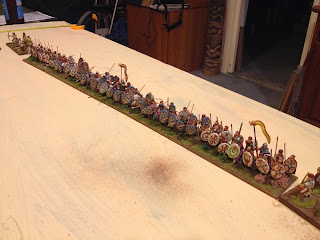
Dux Bellorum, by Dan Mersey, follows the usual format of Osprey's series of wargames rules, providing a self-contained set of rules in 64 pages, lavishly illustrated with Osprey art and photos of miniatures. They scope of the rules is unapologetically narrow, focusing on late- and post-Roman Britain from AD 367-793, evoking the early 'dark ages' world of Nennius and Gildas. The rules are well laid out, clearly explained and really quite straightforward, making this a great little game to give to someone who has had no experience with tabletop wargaming. I will be getting a copy for the school library.
Dux Bellorum also has a lot to offer more experienced gamers. Most of the rules are basically familiar to people who have played games like Impetus. What makes them special is the system Dan came up with of Leadership Points. These are basically a finite resource of command and control that each general allocates to different units under his or her command at the start of a turn. Unlike, say, SAGA, these aren't necessary to activate a unit, but they can be used to boost a unit's combat effectiveness, help it cancel hits, allow it to interrupt an enemy unit's move or make activating a unit possible if it fails the basic Bravery Test required by any unit to allow it to move.
Army lists are straightforward, with each army generally comprising 32 points. On Friday I fielded a Sub-Roman British force of five units of Ordinary Shieldwall, a unit each of bowmen and foot skirmishers, a unit of Ordinary Riders and a mounted general with his retinue. This left me 5 points, with which I purchased an additional Leadership Point (giving me 7 in total) and a 'Strategy' bonus that equipped my Shieldwall with hurled weapons, making them stronger in defenece. My opponent Lawrence fielded a Saxon force of foot warriors, come Ordinary and some Noble (although I can't remember the exact mix).

The British shield wall

Lawrence trying to look like a fierce Saxon
The game played really well, despite my tired Friday night inability to comprehend some simple rules and despite us getting a couple of things completely wrong. I rapidly realised what an interesting and subtle mechanic the Leadership Points are. Deciding when and how to use them is the core of this game, and I think Dan has done a great job of using them to evoke the role of strong leadership in these dark ages battles of limited manouevre and much shoving.

Vikings pretending to be Saxons
I also learned from defeat that lines of Ordinary Shieldwall are quite vulnerable, and need the leavening of some superior troops if they are going to pull their weight!

British cavalry and Saxon warriors locked in combat. The counters represent Leadership Points
All in all, I loved this game, and so did my opponent. I'm really looking forward to giving it another go, especially now that we've cleared up a couple of misunderstandings. Congratulations Mr Mersey!










